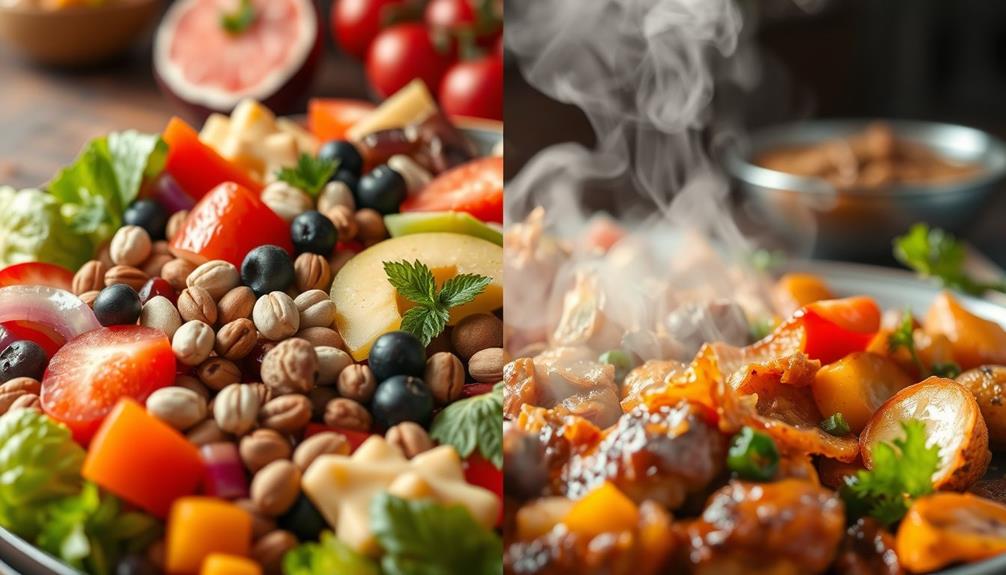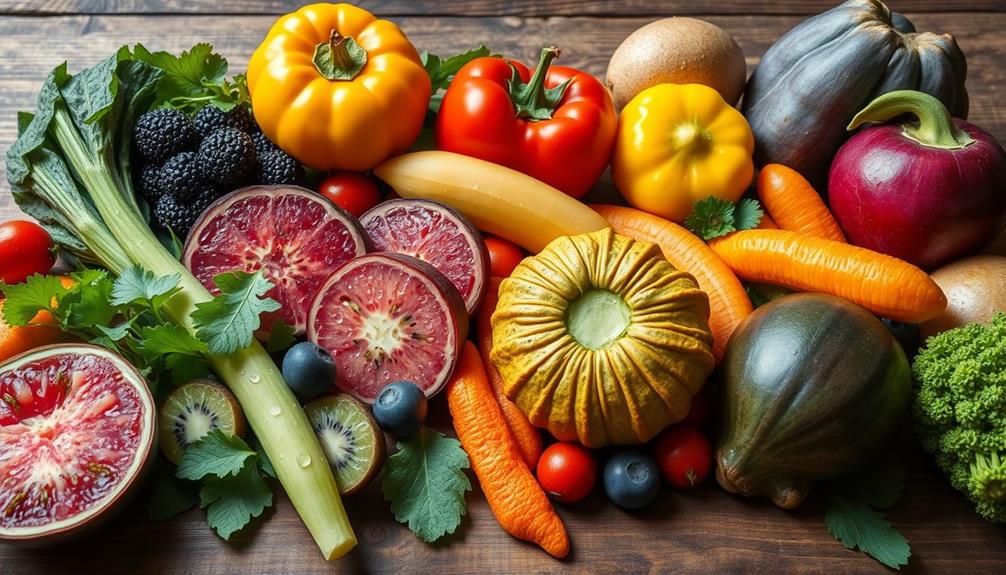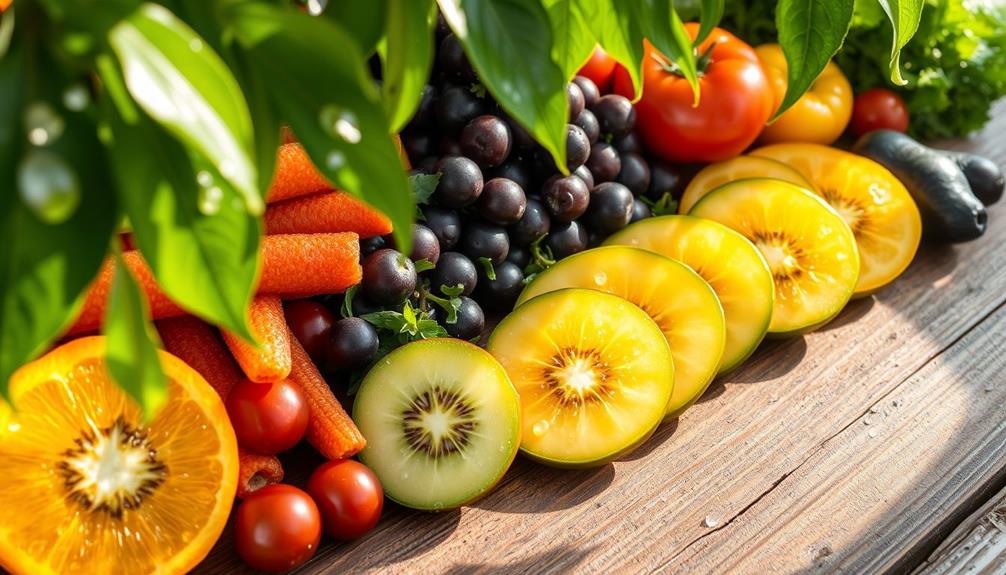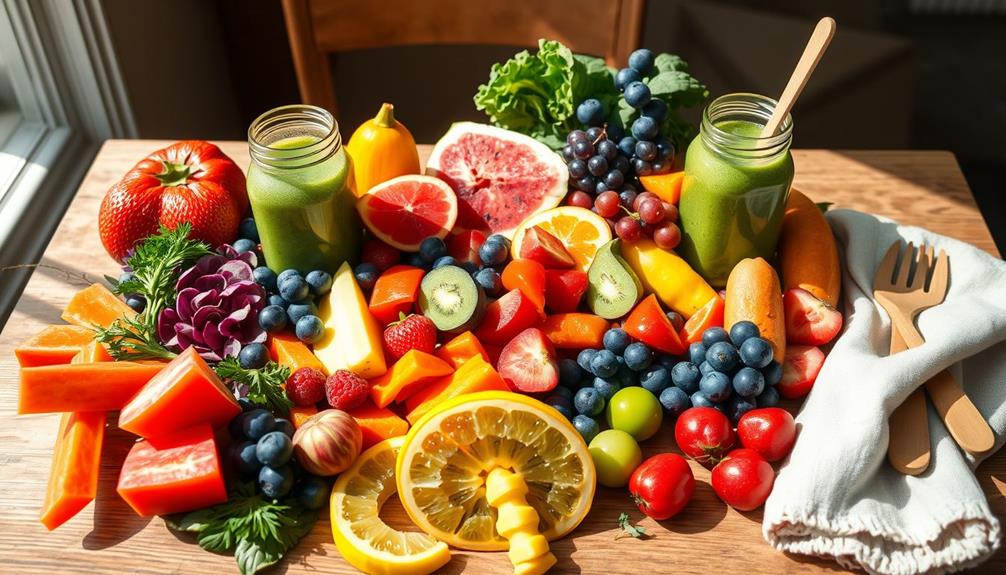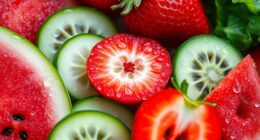Raw food consists of unheated and minimally processed ingredients, focusing on fresh fruits, vegetables, nuts, and seeds. They're packed with water-soluble vitamins and enzymes that support your health. On the other hand, cooked food is prepared through heat, which enhances flavors and makes certain nutrients more bioavailable, like lycopene in tomatoes. Cooking also kills harmful bacteria and improves digestibility. Both types of food offer unique benefits, so exploring a balance between raw and cooked options can optimize your diet. Discover more about how these differences impact your nutrition and overall well-being.
In addition to making nutrients more bioavailable, the benefits of cooking food also include breaking down tough plant fibers, making certain foods easier to digest. Cooking can also create delicious flavors and textures that may not be achievable with raw ingredients alone. By incorporating both raw and cooked foods into your diet, you can harness the benefits of each and create a well-rounded and diverse eating plan.
Key Takeaways
- Raw food emphasizes unheated, uncooked ingredients, preserving higher levels of water-soluble vitamins and enzymes essential for health.
- Cooked food enhances nutrient bioavailability, making certain nutrients easier to absorb, like lycopene in tomatoes and beta-carotene in carrots.
- Cooking improves digestibility by breaking down complex molecules and softening food texture, making it easier to chew and digest.
- Raw foods are generally lower in calories and high in fiber, supporting weight management and digestive health.
- Cooking ensures food safety by killing harmful bacteria and pathogens, reducing the risk of foodborne illnesses.
Understanding Raw Food
When it comes to understanding raw food, it's important to know that this diet emphasizes unheated, uncooked, and unprocessed foods. In a typical raw food diet, you'll often find at least 70% raw fruits, vegetables, nuts, and seeds.
One of the main benefits of eating raw is the preservation of water-soluble vitamins, particularly Vitamin C, which can considerably diminish through cooking. Additionally, raw foods are often rich in antioxidants, providing various health benefits, including potential effects on kidney health.
For instance, consuming raw broccoli can triple the amount of sulforaphane, a compound known for its anti-cancer properties. Cooking can destroy beneficial enzymes like myrosinase found in cabbage, which are essential for fighting cancer. Raw onions and garlic also stand out; raw onions serve as anti-platelet agents that support heart health, while raw garlic retains sulfur compounds that boast anti-cancer benefits.
However, it's important to balance your raw food diet. Without careful planning, you might face nutrient and energy deficiencies.
Understanding Cooked Food
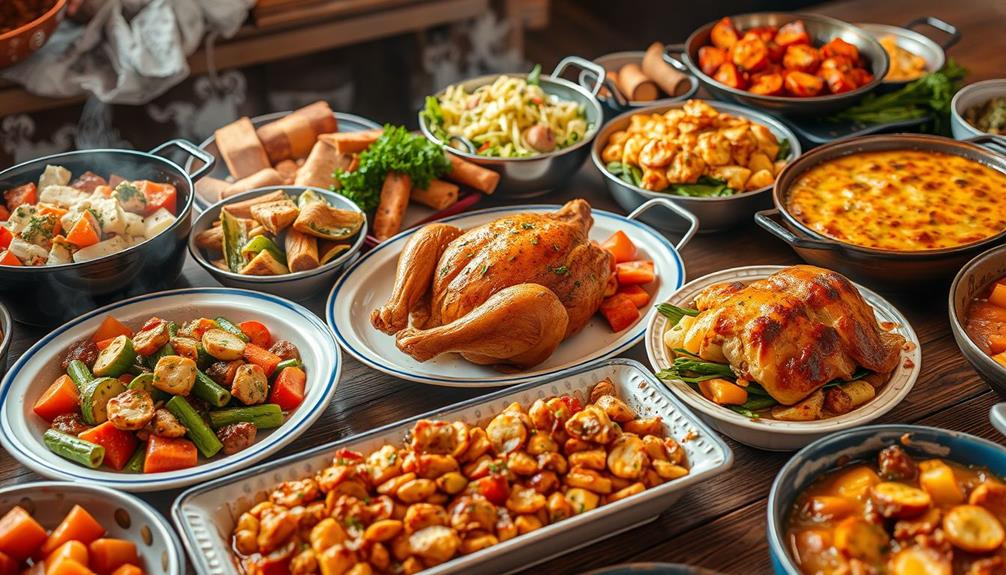
Cooked food plays an essential role in our diets, as it transforms raw ingredients through the application of heat, enhancing flavors and making meals safer to eat. When you cook food, it alters its chemical structure, improving safety by killing harmful bacteria and pathogens. This greatly reduces the risk of foodborne illnesses, especially from raw animal-based foods like meat, fish, and poultry.
Additionally, cooking can make some foods more palatable and enjoyable, which can encourage a healthier eating pattern by incorporating a variety of ingredients, including those beneficial for conditions like gout management.
Moreover, cooking can increase the bioavailability of certain nutrients. For example, lycopene in tomatoes and beta-carotene in carrots become easier for your body to absorb when these foods are cooked. While different cooking methods affect nutrient retention, techniques like steaming or microwaving often preserve heat-sensitive vitamins better than boiling.
The textures and flavors of cooked food also contribute to a more enjoyable eating experience. You can explore various meal preparation options, from simmering to grilling, giving you the freedom to create diverse dishes that cater to your palate.
Furthermore, cooked food can aid digestion by breaking down complex molecules, making it easier for your digestive enzymes to do their job. Overall, cooked food offers numerous benefits that make it a staple in many diets.
Nutritional Benefits of Raw Food
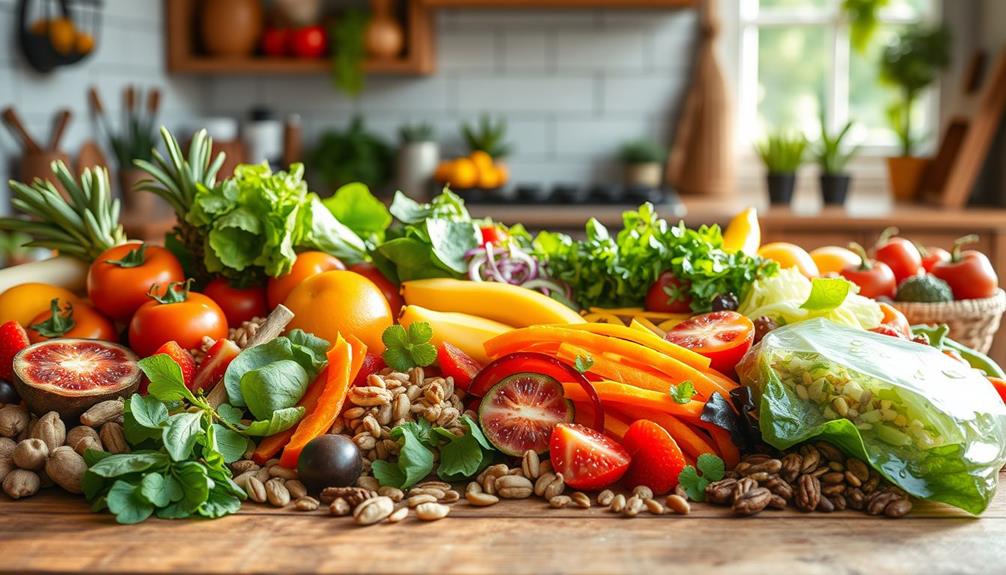
When you choose raw foods, you're maximizing nutrient retention, especially water-soluble vitamins like Vitamin C that cooking can diminish.
Additionally, incorporating more raw foods can enhance your overall health by providing essential enzymes that aid digestion and boost your immune system, much like the benefits of herbal teas for menstrual discomfort.
This approach can also support your weight loss goals by keeping calories in check while boosting your energy levels.
Nutrient Retention in Raw Foods
Eating raw foods offers significant advantages in nutrient retention, particularly when it comes to water-soluble vitamins like Vitamin C. Cooking can drastically reduce these vitamins, but raw foods maintain higher levels, ensuring you get the most nutritional bang for your buck.
By choosing raw options, you also increase your intake of antioxidants, which may help lower the risk of chronic diseases. Additionally, incorporating raw foods can be a great way to diversify your diet, much like how diversifying a retirement portfolio with options like a Gold IRA can safeguard against market volatility.
Take broccoli, for instance; when consumed raw, it can contain up to three times more sulforaphane, a compound linked to cancer-fighting properties. Similarly, raw garlic retains its sulfur compounds, providing you with even more anti-cancer benefits.
These nutrient-rich foods not only bolster your health but also keep your energy levels up, thanks to their high fiber content and lower calorie density.
Incorporating more raw foods into your diet can be a smart strategy for maximizing nutrient retention. By doing so, you not only enhance your overall health but also enjoy the delicious flavors and textures that come with fresh produce.
Raw Foods and Weight Loss
Raw foods not only maximize nutrient retention but also play a significant role in weight loss. These foods are typically lower in calories and higher in water content, helping you feel full without consuming excessive calories.
When you incorporate raw foods into your diet, the high fiber content aids digestion and regulates your appetite, making it easier to maintain a healthy weight. Additionally, certain essential oils, such as eucalyptus oil can support overall health, enhancing your wellness journey alongside a raw food diet.
Moreover, a raw food diet often leads to improved energy levels, encouraging you to engage in more physical activity, which further supports your weight management efforts. By consuming raw fruits and vegetables, you gain higher levels of water-soluble vitamins and antioxidants, which are essential for overall health and may reduce the risk of chronic diseases linked to obesity.
Additionally, raw foods can help lower cholesterol levels, promoting heart health and potentially aiding in weight loss. Unlike cooked foods, which can lose some nutritional value during preparation, raw foods provide you with a wealth of nutrients that support your weight loss journey.
Nutritional Benefits of Cooked Food
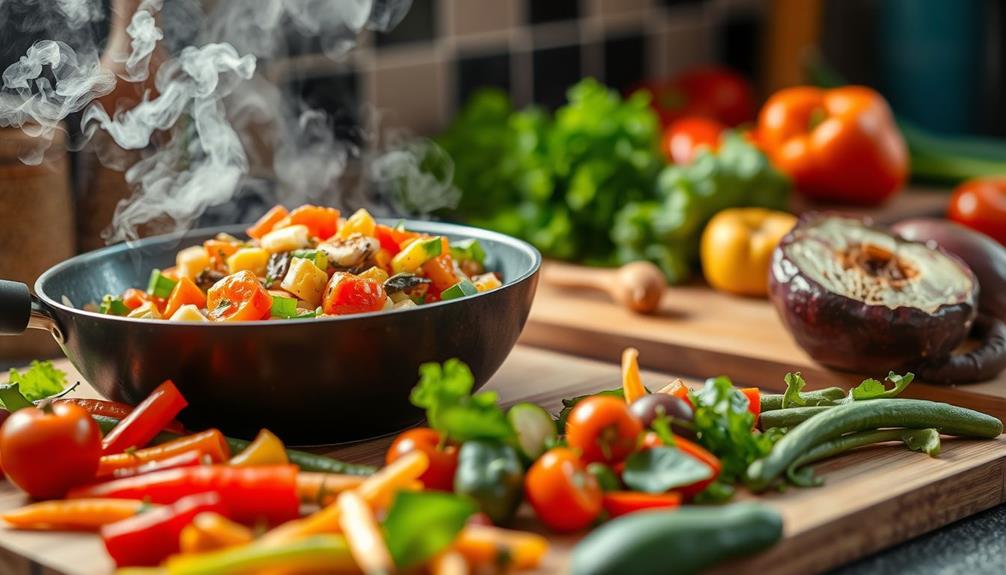
When you cook your food, you enhance the bioavailability of key nutrients, making them easier for your body to absorb.
Cooking also improves digestibility and reduces harmful anti-nutrients, ensuring you get more out of your meals.
Additionally, certain cooking methods can help reduce the risk of foodborne illnesses, much like how mammography aims to detect breast cancer early for better treatment outcomes.
Plus, it boosts food safety by killing off harmful bacteria, giving you peace of mind while you eat.
Enhanced Nutrient Bioavailability
Cooking food can greatly enhance the bioavailability of essential nutrients, making them easier for your body to absorb. When you cook tomatoes, for instance, the lycopene becomes more accessible, and cooking carrots boosts beta-carotene. These nutrients are vital for your overall health, and their enhanced nutrient bioavailability in a cooked diet can make a significant difference.
Additionally, proper cooking methods can increase antioxidant levels in leafy greens, allowing you to reap even more health benefits. In fact, understanding the importance of carrier oils can also provide insight into how cooking can affect the absorption of nutrients in many foods.
Cooking also reduces anti-nutrient levels in grains and legumes, which can inhibit nutrient absorption. This means that enjoying these foods in a cooked diet not only enhances their nutritional value but also makes them easier to digest.
Improved Digestibility
Many people find that cooked food is easier to digest than its raw counterparts. When you cook vegetables and grains, the heat breaks down plant cell walls, making nutrients more accessible. This process leads to improved digestibility, allowing your body to absorb essential proteins and carbohydrates more effectively.
Various cooking methods can enhance the flavor of ingredients, making them not only more nutritious but also more enjoyable to eat, as seen in the brewing methods used for coffee, which considerably affect taste and aroma various brewing methods.
Cooked meat and grains generally pose less strain on your digestive system compared to raw options. Certain cooking methods, like steaming and boiling, can greatly reduce anti-nutrient levels, which helps enhance the absorption of crucial minerals and vitamins.
Moreover, cooking increases the bioavailability of fat-soluble vitamins and antioxidants. For example, beta-carotene in carrots and lycopene in tomatoes become more accessible after cooking, contributing to better overall health and potentially lowering the risks of chronic diseases.
Incorporating both cooked and raw foods into your diet can optimize nutrient intake while promoting better digestive health. By including a variety of cooked foods, you can take advantage of their improved digestibility, ensuring that your body gets the nutrients it needs efficiently.
Food Safety Assurance
For anyone concerned about food safety, cooking is an important step that greatly reduces the risk of foodborne illnesses. By cooking food, you effectively kill harmful bacteria and pathogens that can thrive in raw meats, fish, and poultry. For example, microorganisms like E. coli and Salmonella are often present in raw animal-based foods, and cooking guarantees they're destroyed, making your meals safer.
Additionally, it's important to guarantee that your food is prepared in a clean environment, as proper pet care emphasizes the significance of hygiene to prevent contamination.
Moreover, some foods, such as kidney beans, contain natural toxins that require thorough cooking to eliminate potential health risks. While certain raw foods, like sprouts, can be nutritious, their safety heavily depends on preparation methods and the specific microorganisms involved. That's why cooking these items can be crucial.
Utilizing proper cooking techniques enhances food safety, as different methods vary in their effectiveness against various pathogens. When you prioritize cooking food, you're not just optimizing taste and digestibility; you're also taking significant steps to protect yourself from foodborne illnesses.
Safety Considerations in Cooking
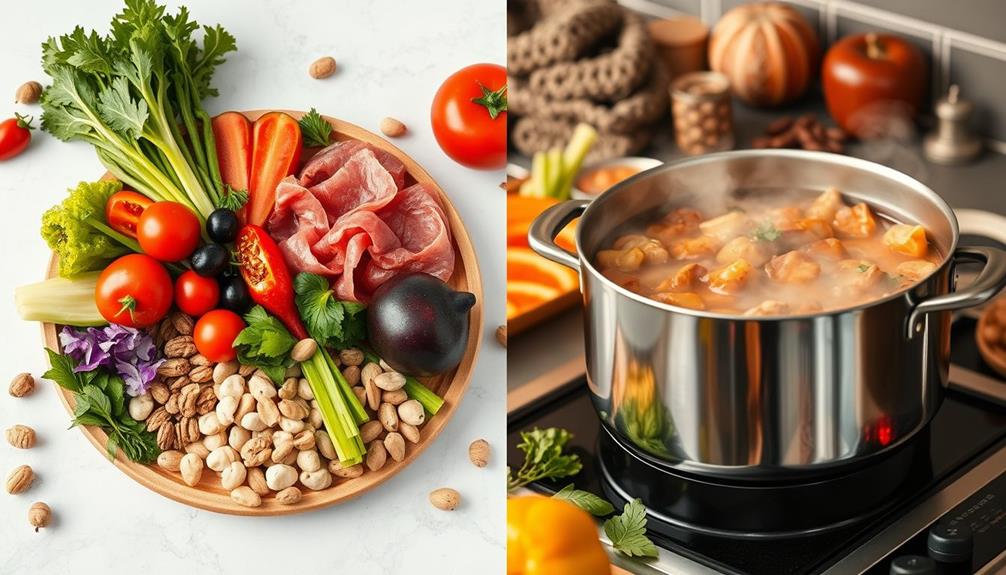
Ensuring food safety is essential when preparing meals, especially when dealing with raw ingredients. Cooking is a vital step in this process, as it effectively kills harmful bacteria and pathogens found in raw foods like meat and poultry. For instance, cooking can greatly reduce the risk of foodborne illnesses caused by pathogens such as E. coli and Salmonella.
However, not all raw foods are free from risk. Some, like spinach and lettuce, can be contaminated and require proper washing. Additionally, certain raw foods contain natural toxins, which cooking can deactivate—take kidney beans, for example, which need to be cooked thoroughly to avoid adverse health effects.
To help you understand the safety considerations better, here's a quick comparison of cooking methods:
| Cooking Method | Effectiveness in Killing Pathogens |
|---|---|
| Boiling | High |
| Frying | High |
| Microwaving | Moderate |
| Steaming | Moderate |
Impact on Digestibility
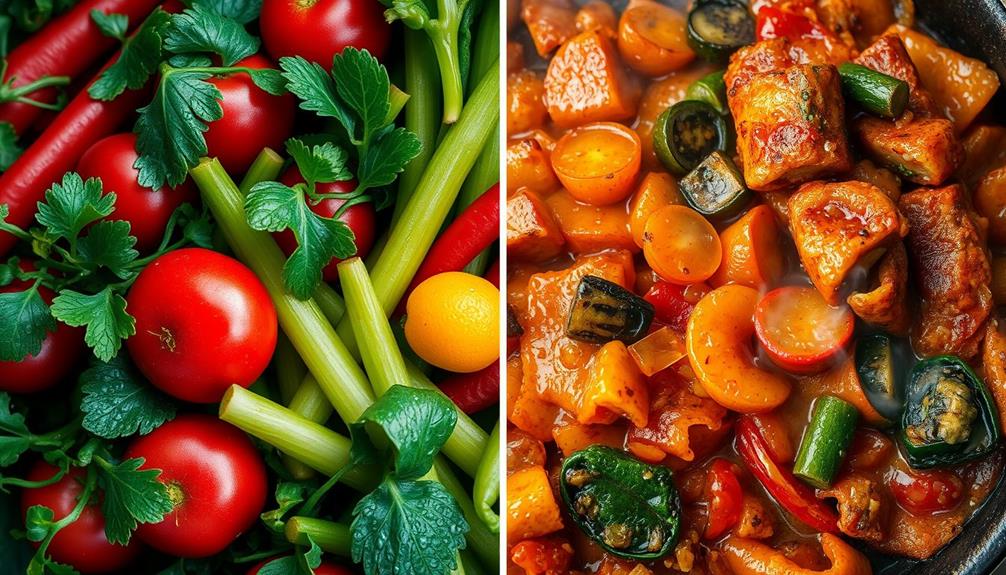
When it comes to digestibility, cooking plays an essential role in breaking down food's structure, making it easier for your body to absorb nutrients. Cooked foods generally have a higher digestibility compared to raw options. For example, cooking breaks down plant cell walls, which helps you digest food more efficiently.
Additionally, certain cooking methods can enhance the flavors and nutritional benefits of foods, such as yoga for back pain that emphasizes holistic management of health. Cooked meats and grains also become softer and more palatable, enhancing their digestibility.
While some people advocate for a raw diet due to the higher levels of certain beneficial compounds in foods like broccoli, cooking can improve the absorbability of nutrients found in other foods, such as spinach.
It's worth noting that the human body produces enough enzymes to digest both raw and cooked foods, so you don't need to rely solely on food enzymes from raw produce.
The cooking method you choose can greatly impact how well you digest food. Techniques like steaming and stir-frying tend to preserve nutrients better than boiling or prolonged cooking.
Ultimately, whether you opt for raw or cooked foods, understanding the impact of cooking on digestibility can help you make informed dietary choices.
Nutrient Preservation Techniques
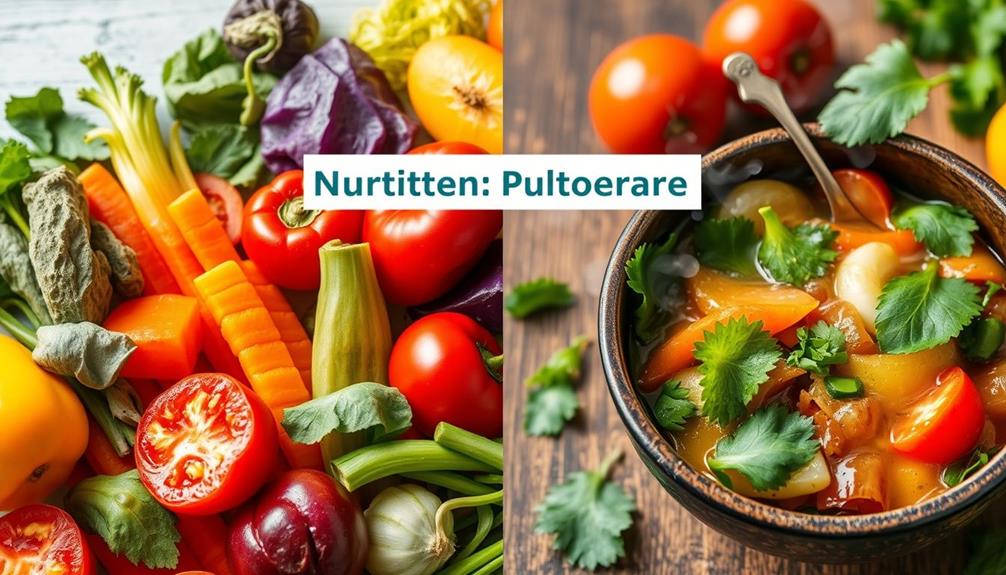
Understanding how cooking affects digestibility naturally leads to exploring nutrient preservation techniques. When you cook, the method you choose can greatly impact nutrient loss. For instance, steaming and microwaving are great options for preserving heat-sensitive vitamins like vitamin C and B vitamins, reducing nutrient loss compared to boiling, which can strip away 50-60% of these vitamins.
You might also be surprised to learn that light cooking techniques can actually enhance the bioavailability of certain antioxidants. For example, lycopene in tomatoes and beta-carotene in carrots become more accessible for absorption when cooked lightly.
However, raw foods tend to retain more water-soluble vitamins and enzymes, particularly in vegetables like broccoli and cabbage, where cooking can destroy important anti-cancer enzymes.
To maximize your nutrient intake, consider proper cooking techniques. Avoid deep frying and excessive cooking times, as these methods can diminish nutritional value.
Instead, aim for a diverse approach by incorporating both raw and lightly cooked foods. This way, you can optimize nutrient preservation and enjoy the health benefits of both raw and cooked foods in your diet.
Balancing Raw and Cooked Diets
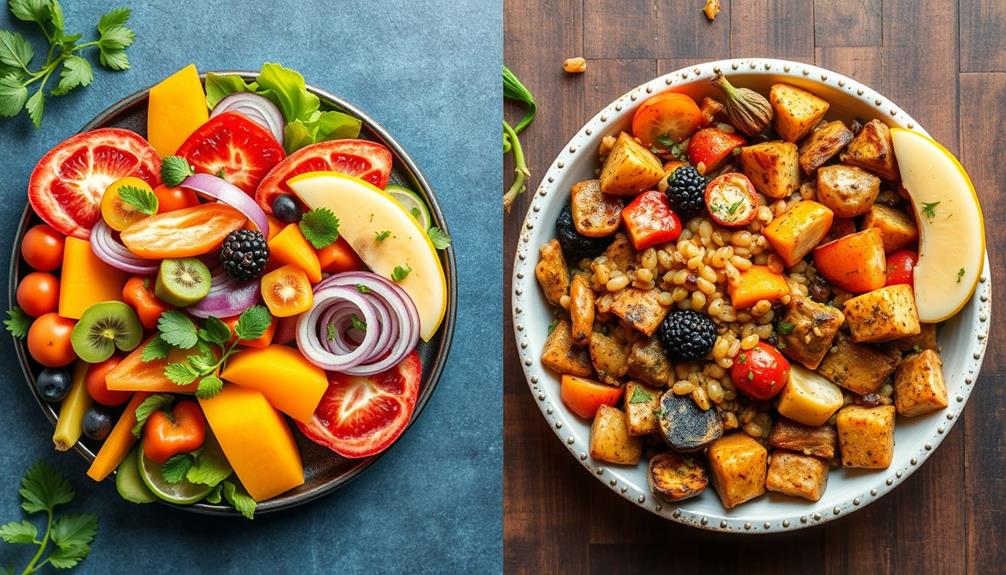
A balanced diet often includes a mix of raw and cooked foods, allowing you to maximize nutrient intake while enjoying the unique benefits of each preparation method. Raw foods, such as fruits and vegetables, retain higher levels of water-soluble vitamins and enzymes that are essential for overall health. On the other hand, cooked foods can enhance the bioavailability of certain nutrients, like lycopene in tomatoes and beta-carotene in carrots.
Incorporating both raw and cooked foods not only provides nutritional diversity but also helps prevent potential deficiencies that can arise from a strictly raw food diet. Traditional eating habits often reflect a natural blend of these two categories, suggesting that cultural practices and personal preferences are crucial in shaping your dietary choices.
Here's a quick comparison of raw and cooked foods:
| Raw Foods | Cooked Foods |
|---|---|
| Higher in vitamins | Enhanced nutrient absorption |
| Retain natural enzymes | Easier digestion |
| Crisp textures | Softer textures |
| Often lower in calories | Can be more filling |
Balancing these options will lead to a more nutritious and satisfying diet.
Popular Raw and Cooked Dishes
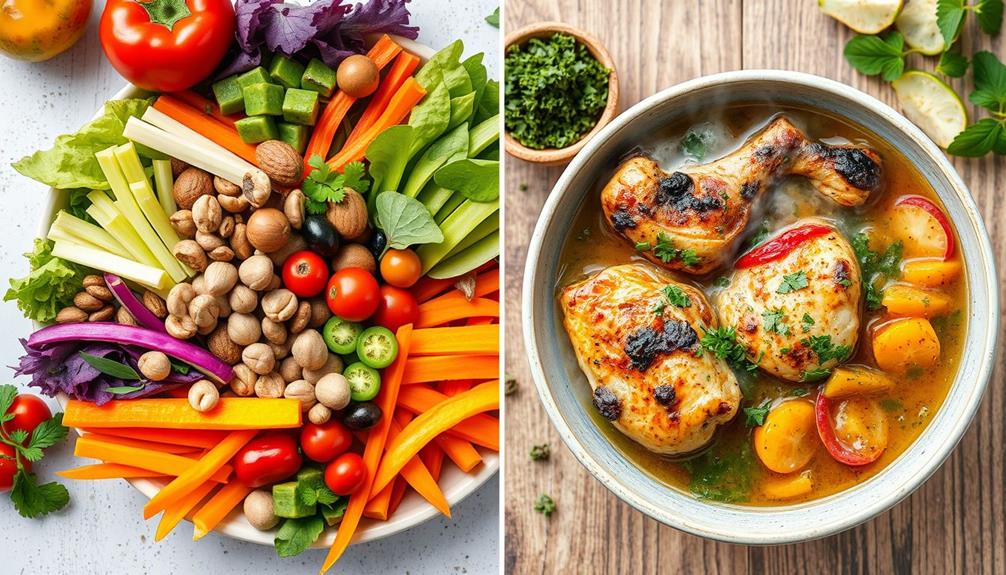
When it comes to popular dishes, you'll find a wide range of options in both raw and cooked categories.
Think of fresh salads and vibrant smoothies on one side, while savory cooked meals like biryani and chicken curry sit on the other.
Each type showcases unique flavors and preparation styles that cater to different tastes and preferences.
Raw Food Examples
Many people enjoy incorporating a variety of raw and cooked dishes into their diets, each offering unique flavors and health benefits. When it comes to raw foods, there's a plethora of delicious options that can easily fit into your meals.
Here's a quick overview of some popular raw and cooked foods:
| Raw Foods | Cooked Foods |
|---|---|
| Fresh salads (leafy greens, tomatoes, cucumbers, avocados) | Biryani |
| Raw fruits (apples, oranges, strawberries, bananas) | Chicken curry |
| Smoothies (blended raw fruits and vegetables) | Pasta |
| Sushi (raw fish or vegetables) | Stir-fried dishes |
These raw foods are packed with nutrients and enzymes that can enhance your overall health. Fresh salads and fruits are not only tasty but also provide essential vitamins and fiber. Meanwhile, smoothies offer a convenient way to enjoy multiple raw ingredients in one drink. Embracing a variety of raw dishes allows you to experience the natural flavors of foods while reaping the benefits of their unaltered nutritional content.
Cooked Food Varieties
Exploring the world of cooked food reveals a rich tapestry of flavors and techniques that elevate simple ingredients into satisfying dishes. From the aromatic spices in biryani to the comforting warmth of chicken curry, cooked food transforms raw foods into delightful meals.
Pasta, with its endless sauce combinations, showcases how heat can enhance flavor and create an inviting dining experience. Cultural variations add depth to cooked dishes. For example, sushi features raw fish paired with vinegared rice, while casseroles blend various cooked ingredients, resulting in a hearty, flavorful dish. Each of these cooked food varieties highlights the creativity in culinary traditions worldwide.
While you enjoy these cooked options, don't forget the value of raw foods like fresh salads, vibrant fruit platters, and energizing smoothies. These dishes retain essential nutrients and enzymes, promoting overall health.
Incorporating both raw and cooked foods into your diet offers a balanced approach to nutrition, with raw foods often being lower in calories and cooked items enhancing nutrient availability, such as lycopene in tomatoes. Embrace the diversity of both categories to enrich your meals and your health.
Expert Insights and Recommendations
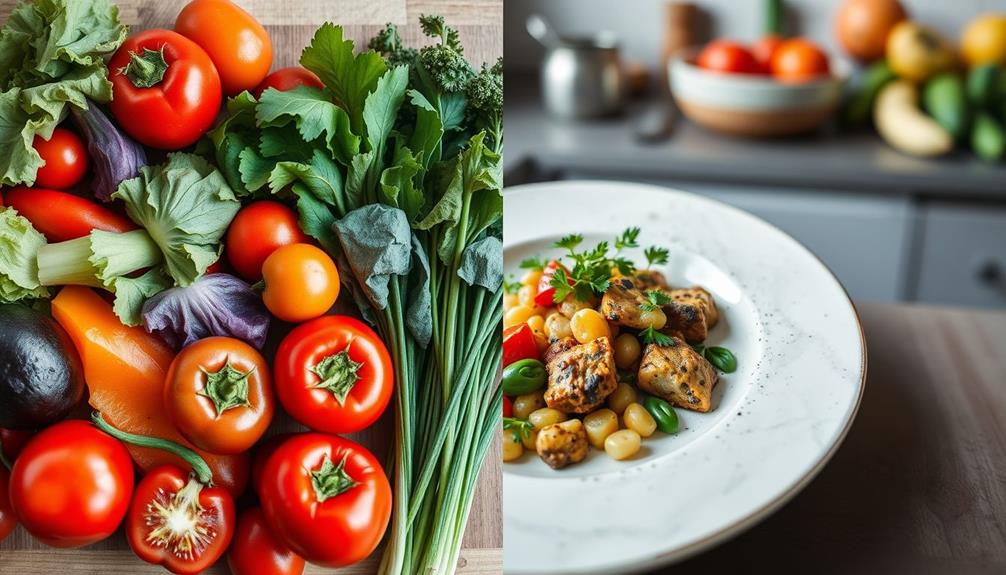
Nutrition experts agree that striking a balance between raw and cooked foods can optimize your health. Raw foods often pack higher levels of water-soluble vitamins, like Vitamin C, and antioxidants, which are essential for chronic disease prevention.
On the flip side, cooking enhances digestibility by breaking down plant cell walls and reducing anti-nutrient levels, making those nutrients more bioavailable.
Moreover, proper cooking techniques considerably lower the risk of foodborne illnesses by eliminating harmful bacteria, especially in animal-based foods. This makes it important to incorporate both raw and cooked foods into your diet to reap the unique health benefits each offers.
Experts also stress that your personal preferences and cultural practices should guide your dietary choices. Understanding nutrient retention and food safety is fundamental, but ultimately, enjoying what you eat is key.
Frequently Asked Questions
How Is Raw Food Different From Cooked Food?
Raw food's fresh and nutrient-rich, while cooked food enhances flavors and safety. You'll find certain nutrients more accessible when cooked, yet raw options retain more water-soluble vitamins, balancing your diet for ideal health benefits. Cooking raw food in air fryer is also a healthier option compared to traditional frying methods, as it uses less oil and produces less harmful compounds like acrylamide. Additionally, air frying can help retain more nutrients compared to other cooking methods, making it a great choice for those looking to maintain the nutritional quality of their food. Whether you choose to eat raw or cooked food, finding a balance between the two can help you reap the benefits of both.
Is It Better to Eat Raw or Cooked Food?
When considering your diet, you'll find both raw and cooked foods offer unique benefits. Embracing a balance between them enhances your nutrient intake and supports your health, catering to your personal preferences and nutritional needs.
What Is an Example of Raw and Cooked Food?
You might enjoy fresh strawberries as an example of raw food, while a hearty chicken curry represents cooked food. Both options offer unique flavors and nutrients, enhancing your meals and contributing to a balanced diet.
What Are Examples of Raw Foods?
Did you know that over 70% of nutrients remain intact in raw foods? You can enjoy fresh fruits like apples and strawberries, crunchy vegetables like cucumbers and carrots, or nutrient-dense nuts and seeds for ideal health benefits.
Conclusion
In the end, both raw and cooked foods have their unique advantages. While raw foods can pack a powerful nutritional punch, cooked foods often enhance flavors and digestibility. It's all about finding the right balance that suits your lifestyle and health needs. Remember, you don't have to throw the baby out with the bathwater; incorporating a mix of both can lead to a diverse and nutritious diet that keeps your meals exciting and beneficial.

